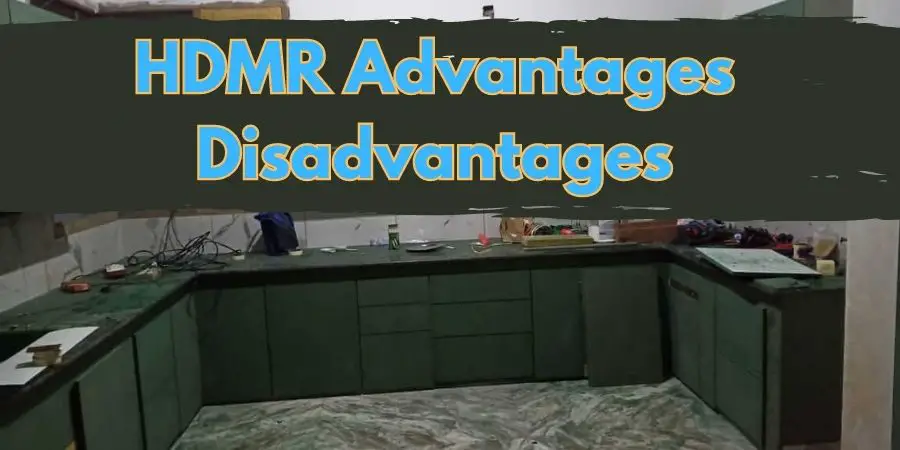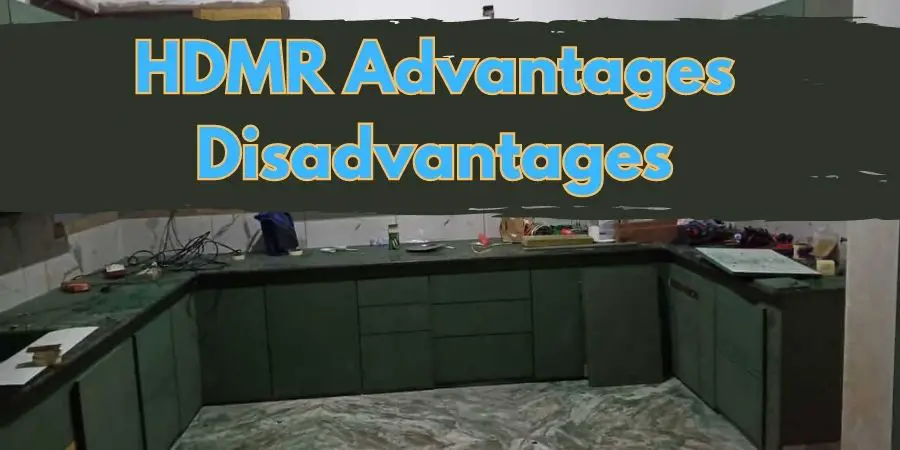HDHMR (High-Density High Moisture Resistant) board is an engineered wood product that’s made from wood fibers and resin. It’s different from other types of engineered wood because it has a higher density and is designed to be more moisture-resistant.

What makes HDHMR board unique is its strength and durability. It’s stronger than particle board and MDF (medium-density fiberboard) and can hold up to heavy weight and impact. Plus, it’s designed to resist moisture and humidity, making it a great choice for applications in high-moisture environments like kitchens, bathrooms, and basements.
Table of Contents
Advantages of HDHMR Boards:
Affordable AF:
If you’re on a budget, HDHMR boards are a lifesaver! They’re way cheaper than solid wood or other types of engineered wood, so you can save some cash without sacrificing quality.
Built to Last:
HDHMR boards are tough cookies. They’re made by compressing wood fibers with resin under high pressure and temperature, which makes them super durable and resistant to warping, cracking, and splitting.
Waterproof:
Got a bathroom or kitchen that needs some love? HDHMR boards are your go-to! They’re highly resistant to moisture and humidity, so they won’t get all moldy and gross over time.
Rock-Solid Stability:
HDHMR boards are like the steady rock in a sea of chaos. They have a uniform composition, which makes them more stable than solid wood and less prone to movement and expansion. So, you won’t have to worry about your furniture or cabinets warping or changing shape over time.
Versatility at its Best:
HDHMR boards are like the Swiss Army Knife of building materials. They can be used in all sorts of applications, from flooring to furniture to cabinetry. So, you can get creative and let your imagination run wild!
Smooth Surface:
HDHMR boards have a smooth, consistent surface that is ideal for painting, laminating, or applying other finishes. This means you won’t have to spend hours sanding or prepping the surface before you start your project.
Eco-Friendly:
HDHMR boards are an eco-friendly choice because they’re made from recycled wood fibers and don’t require the harvesting of new trees. Plus, they can be recycled themselves when they reach the end of their useful life.
Uniform Color:
HDHMR boards have a consistent color throughout, which means you won’t have to worry about variations in color or grain pattern like you would with solid wood.
Easy to Work With:
HDHMR boards are lightweight and easy to cut, drill, and shape with basic woodworking tools. This makes them a great choice for DIYers or professionals who want to save time and effort on their projects.
Low Maintenance:
HDHMR boards require minimal maintenance and can be easily cleaned with soap and water. They don’t require sealing or staining like solid wood, which means you can enjoy your finished project without worrying
Disadvantages of HDHMR Boards:
Not as Strong as Solid Wood:
While HDHMR boards are durable, they’re not quite as strong as solid wood. They’re prone to denting and may not be able to hold heavy weight without support.
Can’t be Refinished:
Unlike solid wood, HDHMR boards can’t be refinished. So, if they become damaged or scratched, you’ll have to replace the entire board instead of just sanding and refinishing the damaged area.
Prone to Swelling:
HDHMR boards can be prone to swelling and expanding if they come into contact with moisture or humidity. This can cause them to warp or bend, which can be a problem for certain applications.
Limited Aesthetic Options:
HDHMR boards have a consistent, uniform appearance, which may not be ideal if you’re looking for a unique or natural-looking finish. They also can’t be stained or painted as easily as solid wood.
Chemicals in Resin:
The resin used to make HDHMR boards may contain formaldehyde, which can be a health hazard if the boards aren’t properly ventilated. Be sure to choose boards with low or no formaldehyde content if you’re concerned about this.
Not Ideal for Outdoors:
HDHMR boards aren’t ideal for outdoor use since they’re prone to swelling and expanding when exposed to moisture. If you need a durable, weather-resistant material for outdoor applications, consider using solid wood or other engineered wood products instead.
Difficult to Repair:
If HDHMR boards become damaged, they can be difficult to repair. Unlike solid wood, they can’t be easily sanded or filled, so you may have to replace the entire board if it’s damaged beyond repair.
Not Fire-Resistant:
HDHMR boards are not fire-resistant, which means they may not be suitable for applications where fire safety is a concern. Be sure to check local building codes and regulations before using HDHMR boards in fire-sensitive areas.
Limited Thickness Options:
HDHMR boards are typically available in limited thickness options, which can be a problem if you need a specific thickness for your project. Be sure to check with your supplier to see what thicknesses are available.
Quality can Vary:
The quality of HDHMR boards can vary depending on the manufacturer and the production process used. Be sure to choose a reputable supplier and check the quality of the boards before purchasing them for your project.
FAQs
Q: What is HDHMR board made of?
A: HDHMR board is an engineered wood product that’s made from wood fibers and resin.
Q: How is HDHMR board different from other engineered wood products?
A: HDHMR board is denser and more moisture-resistant than other engineered wood products like particle board and MDF. It’s also stronger and more durable.
Q: What are some advantages of using HDHMR board?
A: Some advantages of using HDHMR board include its strength, durability, moisture-resistance, sustainability, and easy workability.
Q: What are some disadvantages of using HDHMR board?
A: Some disadvantages of using HDHMR board include its limited aesthetic options, difficulty in repairing, and potential health hazards from the chemicals used in the resin.
Q: Can HDHMR board be used for outdoor applications?
A: HDHMR board is not recommended for outdoor use since it can swell and expand when exposed to moisture.
Q: How is HDHMR board priced compared to other materials?
A: HDHMR board is typically more expensive than particle board and MDF, but less expensive than solid wood.
Q: Can HDHMR board be painted or stained?
A: HDHMR board can be painted or stained, but it may require more preparation than solid wood.
Q: Is HDHMR board eco-friendly?
A: HDHMR board is a sustainable choice since it’s made from recycled wood fibers and can be recycled itself when it reaches the end of its useful life.
Q: Can HDHMR board be cut and shaped with basic woodworking tools?
A: Yes, HDHMR board is lightweight and easy to work with, and can be cut and shaped with basic woodworking tools.





